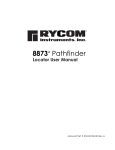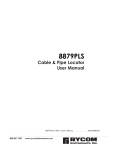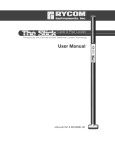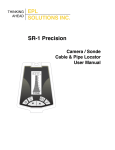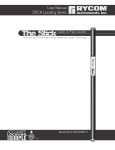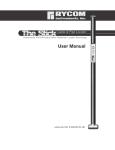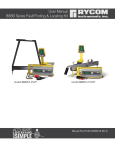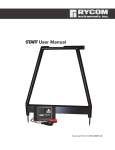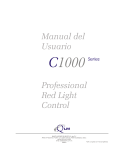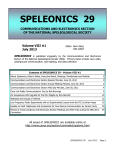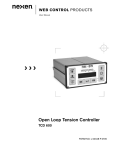Download Manual Covers 8879v4 -10watt 8880v4
Transcript
User Manual 8879v4 Locating Series Manual Covers 8879v4 -10watt 8880v4 - 10watt Manual Part # 030-00107-00 Copyright Copyright © 2015 RYCOM Instruments, Inc. All rights reserved. No part of this manual may be reproduced, copied, modified or adapted, without the prior written consent of the RYCOM Instruments, Inc. Please feel free to contact RYCOM Instruments, Inc. to request permission for reproduction and use of this manual for training purposes. 800.851.7347 www.rycominstruments.com Table of Contents General Information Introduction . . . . . . . . . . . . . . . . . . . . . . . . . . . . . . . . . . . . . . . . . . . . . . . . 2 Disclaimer of Liability . . . . . . . . . . . . . . . . . . . . . . . . . . . . . . . . . . . . . . . . 2 Important Notices . . . . . . . . . . . . . . . . . . . . . . . . . . . . . . . . . . . . . . . . . . . 2 Prepare for Use . . . . . . . . . . . . . . . . . . . . . . . . . . . . . . . . . . . . . . . . . . . . . 3 Register Extended Warranty . . . . . . . . . . . . . . . . . . . . . . . . . . . . . . . . . . 3 Transmitter Controls and Indicators . . . . . . . . . . . . . . . . . . . . . . . . . . . . 4 Direct Connect . . . . . . . . . . . . . . . . . . . . . . . . . . . . . . . . . . . . . . . . . . . . . 5 Flexicoupler Connection . . . . . . . . . . . . . . . . . . . . . . . . . . . . . . . . . . . . . 5 Inductive Connection . . . . . . . . . . . . . . . . . . . . . . . . . . . . . . . . . . . . . . . 6 Blind Search . . . . . . . . . . . . . . . . . . . . . . . . . . . . . . . . . . . . . . . . . . . . . . . . 6 Selecting the Tracing Signal . . . . . . . . . . . . . . . . . . . . . . . . . . . . . . . . . . 7 Receiver Controls and Indicators . . . . . . . . . . . . . . . . . . . . . . . . . . . . . . 8 Locating the Cable or Pipe . . . . . . . . . . . . . . . . . . . . . . . . . . . . . . . . . . . 9 Selecting the Locating Mode . . . . . . . . . . . . . . . . . . . . . . . . . . . . . . . . . 9 Peak Locating Mode . . . . . . . . . . . . . . . . . . . . . . . . . . . . . . . . . . . . . 9-10 Null Locating Mode . . . . . . . . . . . . . . . . . . . . . . . . . . . . . . . . . . . . . . . . 10 Left/Right Auto-Gain Mode . . . . . . . . . . . . . . . . . . . . . . . . . . . . . . . . . . 11 Absolute Signal Strength . . . . . . . . . . . . . . . . . . . . . . . . . . . . . . . . . . . . 11 Gain Change Indication . . . . . . . . . . . . . . . . . . . . . . . . . . . . . . . . . . . . 11 Passive 50/60 Hz Locating . . . . . . . . . . . . . . . . . . . . . . . . . . . . . . . . . . . 12 Passive Radio Frequency Locating . . . . . . . . . . . . . . . . . . . . . . . . . . . 12 Passive Rectifier CP Locating . . . . . . . . . . . . . . . . . . . . . . . . . . . . . . . . 12 Push Button Depth . . . . . . . . . . . . . . . . . . . . . . . . . . . . . . . . . . . . . . . . . 13 Current Measurement . . . . . . . . . . . . . . . . . . . . . . . . . . . . . . . . . . . . . . 13 Depth Measurement 45 Degree Angle Method . . . . . . . . . . . . . . . . 14 Tilted Magnetic Field Identification . . . . . . . . . . . . . . . . . . . . . . . . . . . 14 Locating a Sonde . . . . . . . . . . . . . . . . . . . . . . . . . . . . . . . . . . . . . . . . . . 15 Sonde Depth Measurement . . . . . . . . . . . . . . . . . . . . . . . . . . . . . . . . . 16 STAFF Fault Finder Controls . . . . . . . . . . . . . . . . . . . . . . . . . . . . . . . . . . 17 Fault Locating . . . . . . . . . . . . . . . . . . . . . . . . . . . . . . . . . . . . . . . . . . . . . 18 8879v3 Transmitter Specifications . . . . . . . . . . . . . . . . . . . . . . . . . . . . . 22 8879v3 Receiver Specifications . . . . . . . . . . . . . . . . . . . . . . . . . . . . . . . 23 Factory Service . . . . . . . . . . . . . . . . . . . . . . . . . . . . . . . . . . . . . . . . . . . . 24 Warranty . . . . . . . . . . . . . . . . . . . . . . . . . . . . . . . . . . . . . . . . . . . . . . . . . . 24 Parts List . . . . . . . . . . . . . . . . . . . . . . . . . . . . . . . . . . . . . . . . . . . . . . . . . . 25 800.851.7347 www.rycominstruments.com Introduction Congratulations on the purchase of your new RYCOM 8879v3 Series Cable, Pipe & Fault Locator. The 8879v3 Locator is specially designed to detect pipes, sondes & buried cables. This device may detect buried power cables, CATV cables, gas and water pipes, sewer lines, telecommunication lines, fiber optic cables with sheath, sondes, inspection camera transmitters. You have chosen a quality product that is designed for years of field use without the need for annual or periodic calibration and service. The basic principle of the locator's operation is as follows: The Transmitter emits a signal to a conductive cable or pipe. The Receiver detects the electromagnetic field that is generated by the transmitted signal. You can locate the relative position of the buried utility by following the tracing signal. For safely & to help ensure the best locating results, please read & understand the manual in its entirety before using the product. Disclaimer Of Liability RYCOM Instruments, INC shall not be liable to Distributor, Reseller, or any other person for any incidental, indirect, special, exemplary or consequential damages, or injury of any type whatsoever, and caused directly or indirectly by Products sold or supplied by RYCOM INSTRUMENTS, INC. Important Notices WARNING! Failure to follow these warning could result in serious injury or death. Only persons qualified and trained to operate cable & pipe locators may operate this equipment. Follow appropriate safety procedure, your companies policies and applicable safety codes and/or laws. WARNING! Do not connect to utilities, cables or pipes without authorization and training. Use tool only for intended purpose as described in this manual Do not expose tool to rain or moisture. WARNING! Do not expose to hazardous chemicals, hazardous gas or explosive environment. WARNING! SHOCK HAZARD - Lethal voltages may be present at the transmitter's output. Turn off transmitter before touching test lead or any un-insulated conductor. Make connection to ground and target conductor before turning on transmitter. WARNING! SHOCK HAZARD - Do not connect to live voltage or active utility lines. De-energize any circuits in or around the work area. WARNING! This tool is designed to detect electromagnetic field emitted from cables and buried metallic utilities. There are buried cables, pipes, and utilities this instrument CANNOT detect. WARNING! LOCATING is not an exact science. The only certain way to be sure of the existence, location, or depth of buried utilities is to carefully expose (dig up) the utility. 800.851.7347 www.rycominstruments.com Prepare for Use Unpack your new 8879v4 Locator . Make sure there is no shipping damage and all the parts are included. Locate the battery compartment on the back of the of the Receiver. Open the compartment using a Phillips screwdriver. Install the six Duracell® “C” batteries as marked. For an alkaline transmitter, locate the battery compartment on the bottom of the of the Transmitter. Open the compartment using a Phillips screwdriver. If using an 8879 style transmitter install twelve Duracell® “D” batteries as marked. For rechargeable transmitters, please charge the transmitter for at least 5 hours before use. Note: For longer battery life and reliable operation under adverse conditions, use only Duracell® alkaline batteries. Register Extended Warranty By registering your unit online at http://www.rycominstruments.com/extended.html within one month (30 Days) of purchase RYCOM will extend the warranty period from one year to 4 years. This instrument is under warranty for one year from the date of delivery against defects in material and workmanship (EXCEPT BATTERIES). We will repair or replace products that prove to be defective during warranty period. This warranty is void if, after having received the instrument in good condition, it is subjected to abuse, unauthorized alterations or casual repair. No other warranty is expressed or implied. The warranty described in this paragraph shall be in lieu of any other warranty, including but not limited to, any implied warranty of merchantability or fitness for a particular purpose. We are not liable for consequential damages. 800.851.7347 www.rycominstruments.com Changing Preset Frequencies The 8879 receiver operating frequencies are user programable and can be changed at anytime through a quick selection process. To selct the desired frequency set: • Press and hold depressed the Power On Button. • Pressing the Information Button will toggle through avaiable configurations. Repeat pressing until u3 is displayed in the Frequency Indicator section of the LCD. • Release the Power On Button and the unit will turn off. • Press and hold depressed the Power On Button. • Press the Frequency Button to toggle through the available frequencies. • To select and store the desired frequency press the Information Button. The count of the selected frequency will be displayed on the LCD. • Continue to toggle through and select the desired frequencies, • Releasing the Power On Button will save the selected frequencies for avaiability during normal operation. The 8879 transmitter operating frequencies are user programable and can be changed at anytime through a quick selection process. To selct the desired frequency set: • Press and hold depressed the Power On Button. • Pressing the Information Button will toggle through avaiable configurations. Repeat pressing until u3 is displayed in the Frequency Indicator section of the LCD. • Release the Power On Button and the unit will turn off. • Press and hold depressed the Power On Button. • Press the Frequency Button to toggle through the available frequencies. • To select and store the desired frequency press the Information Button. The count of the selected frequency will be displayed on the LCD. • Continue to toggle through and select the desired frequencies, • Releasing the Power On Button will save the selected frequencies for avaiability during normal operation. 800.851.7347 www.rycominstruments.com 815 Hz Transmitter Controls & Indicators LOADING 8 kHz I/O I Output Level Indicator 82 kHz Load Rate Indicators Output Signal Level Control DFF F.1 F.2 mA v I/O Tx Output Jack CAUTION Lethal Voltages May Be Present High Power Output Indicator LOADING 8 kHz kM I Relative Resistance, Volt, Current 8878 815 Hz kHz TX OUTPUT Frequency Selector 82 kHz Battery Condition Indicator PLACE ARROWS ALONG CABLE PATH FOR INDUCTIVE MODE Signal Information Selector Power On & Off TX OUTPUT JACK The Red/Black Cord, Coupler and Flexicoupler connects here to create a circuit on the buried utility. FREQUENCY SELECTOR This button toggles through the available frequencies. The selected frequency is displayed on the LCD. When dual frequency transmission options are selected, indicated by the F1 & F2 icons to the right large numeric segments, the frequencies will flash from one to another. To activate DFF Fault Finding mode, press and hold for 5 seconds. When release the transmitter will be in DFF mode and the DFF icon will appear on the LCD. LOAD INDICATOR (visual & audible) The Load Indicator symbol flashes to indicate signal output. The quick triple beep audible tone indicates the circuit is open and no signal is being transmitted. A steady continuous beep indicates a closed circuit and signal is transmitted . When the indicator blinks 4 times per second, it is indicating a nearly short circuit. When the indicator blinks 1 time every 10 seconds, it is indicating a nearly open circuit. OUTPUT SIGNAL LEVEL CONTROL The OUTPUT SIGNAL LEVEL CONTROL adjusts the power output from the Transmitter. There are 5 selections on the standard power setting and 5 selections on the HPO setting. The standard power output maximum is 30volts. In the HPO setting the maximum voltage is 130volts. Holding down the Output Signal Level button for 3 Seconds will activate the High Power Output mode. WARNING! High Power Output is a SHOCK HAZARD - Lethal voltages at the transmitter's output. Turn off transmitter before touching test lead or any un-insulated conductor. Make connection to ground and target conductor before turning on transmitter. SIGNAL INFORMATION SELECTOR The unit can display the relative resistance, current and voltage of the transmitted signal. The resistance is based on the feed back from the selected frequency and is not an actual impedance meter. The selections can be toggled by pressing the SIGNAL INFORMATION button. 800.851.7347 www.rycominstruments.com Direct Connection CAUTION DO NOT CONNECT TO LIVE OR ENERGIZED POWER CABLES Direct Connection is the most reliable method of signal application. This method is relatively free of interference. The greatest amount of signal strength can be achieved by this method. Low, mid, and high frequency may be used. The far end of the utility must be grounded. Connect the Red Test Cord to an existing ground point or an exposed metallic section of the utility . Place the Ground Rod approximately 10 feet from this point, at an angle of 90º to the buried cable or pipe. Push the Ground Rod into the ground 8 to 10 inches. Connect the Black Test Cord to the Ground Rod. Plug the Red/Black Test Cord into the TX OUTPUT JACK. Press the FREQUENCY Button for 815 Hz, 8 kHz, 33 kHz or 82 kHz. The Power Output Indicator and the Frequency light of the chosen frequency will light up. TRANSMITTER BLACK RED BURIED CABLE Coupler & Flexicoupler Connection The optional Flexicoupler and Hard Coupler are very easy to use, and services do not have to be interrupted. The operation range is shorter than for Direct Connection methods. The tracing signal can be affected by neighboring cables and pipes. The Red/Black Test Cord or the Ground Rod are not needed for this method. Successful coupler operation requires an insulated conductor that is grounded on both near and far ends. Loop the Flexicoupler around the cable and connect the two ends, or clamp the Hard Coupler around the cable. It is important to connect the coupler around the cable needing to be traced. Connect the coupler around the wire closer to the outgoing cable not near the system ground. The result will be a stronger signal. By connecting near the grounding, the range will also be shorter, and difficulty may arise determining one cable from another. Plug the Coupler into the TX OUTPUT JACK. Some couplers are frequency specific others can operate on any frequency from 8kHz to 82kHz. TRANSMITTER FLEXICOUPLER BURIED CABLE 800.851.7347 www.rycominstruments.com Inductive Connection This method is convenient to use, and services are not interrupted. No test cords or connections are needed. The cable or pipe must have good insulation or non-conductive coating, or the operating range will be short. Turn the Transmitter ON. Select 33kHz through 478 kHz. Place Transmitter on its side as close as possible to the path of the cable or pipe. Align the ARROWS on the SIDE OF THE TRANSMITTER in line with the cable or pipe. First, locate the broad Transmitter Null, then move toward the expected cable path while looking for the signal carried by the cable. Start tracing the path with the Receiver 25 feet from the Transmitter. Search in the 90º zone as shown above. Locate the cable or pipe, and follow the path. If the signal becomes weak, move the Transmitter to a point 25 feet behind the last strong signal, and continue searching. TRANSMITTER 25 Feet (7.5 Meters) Between Transmitter and Reciever Blind Search The Blind Search locating techniques is used if the operator is not aware if a buried utility exists. Two people are needed for this technique. The Transmitter and the Receiver are Held 25 feet away from each other. Each operator walks at the same speed keeping a distance of 25 feet from each other. When the receiver gives an audio response, then a buried utility is present between the Receiver and the Transmitter. TRANSMITTER RECEIVER 25 Feet (7.5 Meters) Between Transmitter and Reciever RECEIVER 800.851.7347 www.rycominstruments.com Selecting the Tracing Signal The choice of 815 Hz, 8 kHz, 33kHz or 82 kHz Frequency is dependent on the conditions of the locate. The 815 Hz, 8 kHz, 33kHz and 82 kHz signals each have their advantages. It is recommended to begin by using the 815 Hz signal, and continue as long as you are confident in the results. If the signal is very weak try to adjust the connection or grounding. If there is no improvement in signal then try 8 kHz. Repeat adjustments of ground and connection point again until switching to 33 kHz and then 82 kHz. 815 Hz (lower frequency) signal is usually preferred to the 8 kHz (mid-range frequency) and 82 kHz (high frequency) signal, because it is much less susceptible to locating errors caused by nearby cables or pipes. The 815 Hz locating range is also much longer than the 82 kHz signal. The 815 Hz signal will not travel well through disconnected shield bonds or insulated pipe bushing. 8 kHz and 33kHz takes the best of both high and low frequency. This mid range frequency is not very susceptible to bleed off or coupling, but it can jump impedance on the utility better than the 815 Hz. It is still best to use 815 Hz, but 8 kHz is one of the most common frequencies used to locate coaxial cable and telecom pairs. The 82 kHz (higher frequency) is sometimes better than the 815 Hz (lower frequency) for locating sharp corners in cables or pipes. The 82 kHz signal is also better for “jumping” disconnected shield bonds or grounds, or tracing signal may indicate one of these characteristics. The locating range is quite short for the 82 kHz signal so the Transmitter must be repositioned more often during the tracing operation. This frequency is also useful for applying a signal using the Flexicoupler or the Hard Coupler. 800.851.7347 www.rycominstruments.com 8879v3 Receiver Controls & Indicators DISPLAYS ABSOLUTE SIGNAL STRENGTH OR DEPTH OPERATION MODE Displays selected operation available to model MEASURES DEPTH (+ Shift Key MEASURES CURRENT) RELATIVE SIGNAL STRENGTH BAR GRAPH (single bar shows gain setting) ON/OFF BUTTON DISPLAYS SELECTED FREQUENCY FREQUENCY SELECTOR (+ Shift Key toggles on/off backlight) MODE SELECTOR (+ Shift Key toggles volume) ADJUSTS GAIN UP OR DOWN SHIFT KEY Hold while selecting secondary key functions ON/OFF Button The unit will load settings from previous usage. Automatic shut off after 10 minute of no use. FREQUENCY Button Toggles through available active and passive frequencies (model specific). Note: Some frequencies are only avaiable in certain modes and some modes will only be avaiable with certain frequencies. MODE Button Toggle through available mode (model specific). PEAK, PINPOINT PEAK, NULL, LEFT/RIGHT, ACC (when an accessory is plugged in) DFF and SONDE locating modes. To select SONDE mode press and hold MODE key for 5 seconds. When released the unit will toggle to SONDE mode. Hold for 5 seconds to exit SONDE mode. To select DFF mode used for Fault finding with an A-frame or for Direction Signal locate mode, press and hold the MODE button for 10 seconds. Hold for 10 seconds to exit DFF mode. DEPTH & CURRENT Button DEPTH function will first momentarily display the depth mode (Line [LIN] or Sonde [SON]) and then display depth measurement at the top of LCD. NOTE: To change the Depth Measurement from English to Metric, hold the Frequency Key for ten seconds. CURRENT measures the relative amount of transmitted current and is displayed at the bottom of the LCD. GAIN Button (Up or Down) Adjusts the gain up or down. If the signal strength shows as “ --- ” on the display, pressing the GAIN will automatically adjust to 85% on the scale display. + VOLUME (SHIFT Button + MODE Button) Toggle volume through High, Medium, Low and Off. + BACKLIGHT (SHIFT Button + FREQUENCY Button) Hold the SHIFT Key and press the CURRENT key to toggle on and off the back light. 800.851.7347 www.rycominstruments.com Locating Modes There is a variety of locating modes available in the 8879v3 unit. PEAK, PINPOINT PEAK, NULL LEFT/ RIGHT GUIDANCE, SONDE, DFF & ACC. To toggle through PEAK, PINPOINT PEAK & NULL simple press the mode button. To toggle to SONDE mode hold the MODE button for 5 seconds and release. DFF and ACC modes are only selectable when an appropriate accessory is plugged into the accessory port in the handle of the receiver. Peak Mode Locating With the Receiver in a vertical position. Move the Receiver left to right across the path. When the Receiver is directly above the cable or pipe, rotate the Receiver for a maximum signal. As you move the Receiver away from the cable path, the meter reading (and audio frequency response) will drop off. If you rotate the Receiver while over the cable, a sharp NULL will identify the cable’s direction. It is aligned with the flat side of the Receiver. CABLE PATH MAXIMUM RECEIVER SIGNAL 800.851.7347 www.rycominstruments.com CABLE PATH NULL SHOWS CABLE DIRECTION Trace the path by walking away from the Transmitter at a moderate pace. Move the Receiver to the left and right while walking, following the PEAK indications. As you trace the path, the PEAK meter reading may slowly fade as you move away from the Transmitter. Press and release the GAIN buttons as needed to compensate for changes in level (higher or lower). One of the following may occur: a) a junction where the signal divides and goes several directions. b) a break in the cable or shield. c) a change in the depth of the cable or pipe. d) an insulated pipe fitting. e) a slack loop of cable. If you can no longer trace the path, even with the GAIN set to maximum, connect the Transmitter to the far end of the path and trace back to the point where you lost the signal. Mark the straight sections of the path every few feet. Mark sharp curves, loops, and cable bundles every few inches. Sharp changes in the path cause the Receiver PEAK and NULL indications to behave differently than when tracing a straight path. Practice on the path that you know has turns and laterals in it. This will help you to recognize the conditions within the field. Null Mode Locating Move the Receiver left to right across the cable path. When the Receiver is directly above the cable or pipe, a NULL (lowest meter reading and lowest audio tone) will occur. When moving the Receiver to left or right of the NULL point, the meter reading will rise to a maximum point (PEAK). The audio tone will also be at its highest pitch. When the Receiver is moved beyond the PEAK, the meter reading will begin to fade. Trace the path by walking away from the Transmitter at a moderate pace. Move the Receiver to the left and right when walking, following the NULL indications. Peak Mode Receiver Max Signal over cable Buried cable 800.851.7347 (End view) Null Mode Receiver Min Signal over cable Buried cable www.rycominstruments.com (End view) Left Right Auto Gain Directional Locating In this mode the unit will display directional arrows to the conductor. The audio indicator will provide a solid tone on one side of the conductor and a pulsed tone on the opposite side of the conductor. When the unit is centered in the electromagnetic field the tone will null and the depth will briefly display at the top of the LCD. This mode is gain independent. Absolute Signal Strength The 8879v3 Receiver provides the operator with a direct measurement of the Receiver’s signal strength. The measurement is displayed with three numerical digits (ex: 485) located at the top of the LCD display. The measurement range is from 0 to 999 indicating a very week signal (0) to a very strong signal (999). Absolute Signal Strength is independent of the GAIN setting or meter reading. It gives the operator information about the actual amount of signal being radiated from the conductor and received by the Receiver. Measuring Absolute Signal Strength at any time is done by reading the number at the top of the LCD display. The Absolute Signal Strength will not be displayed if the meter reading is too high or too low. Adjust the GAIN to move the meter reading to mid-scale. The numerical display will change from ‘---’ to a valid measurement. Absolute Signal Strength measurements are more sensitive to signal changes than the meter display. PEAKS and NULLS can be more precisely pin-pointed. This measurement can also be used to monitor signal loss as the conductor is being traced. Gain Level Indication The GAIN up and down buttons are used to increase and decrease the gain in small amounts. If the meter reading is very low, pressing the GAIN up button will center the meter reading to mid-scale. Likewise, if the meter reading is very high, pressing the GAIN down button will center the meter reading to mid-scale. 800.851.7347 www.rycominstruments.com Passive 50/60 Hz Locating The 8879v3 Receiver is capable of locating power utility frequencies. This MODE is useful for locating underground primary and secondary power utilities. In certain circumstances, this MODE will also locate water pipes, sewer lines, cable television, and telephone. The reason is that common electrical grounds are sometimes found among these various utilities. Select 50Hz or 60Hz frequency on the Receiver. PINPOINT PEAK mode will automatically be selected as the preferred method to locate the conductor in passive power mode. This method is useful because of its speed and convenience. Start at a known reference point and keep in mind that other conductors in the area may produce this same locating signal. The Transmitter is not required to locate in this mode. Note: The unit of depth measurement determines the selection of either 50Hz or 60Hz passive mode. The unit is configured for 50Hz when in Metric Measurement mode and 60Hz when in English Measurement Mode. To change unit of measurement press and hold the frequency button for 10 seconds, when released the unit will toggle measurement units. Passive Radio Frequency Locating The 8879v3 Receiver is capable of passively locating metallic utilities where radio frequencies have coupled to the utility. This mode is useful for sweeping a green area for utilities. In certain circumstances, this mode will locate water pipes, cable television, gas lines and telephone. This locating option does not always detect buried utilities even when radio frequencies are present. This method is useful because of its speed and convenience. Start at a known reference point and keep in mind that other conductors in the area may produce this same locating signal. The Transmitter is not required to locate in this mode. Passive Rectifier CP Locating The 8879v3 RECEIVER is capable of locating the rectified signal of Cathodically Protected utilities at 120Hz and 100Hz. This method is useful because of its speed and convenience. Start at a known reference point and keep in mind that other conductors in the area may produce this same locating signal. Note: The unit of depth measurement determines the selection of either 100Hz or 120Hz passive mode. The unit is configured for 100Hz when in Metric Measurement mode (for 50Hz power) and 120Hz (for 60Hz power) when in English Measurement Mode. To change unit of measurement press and hold the frequency button for 10 seconds, when released the unit will toggle measurement units. The TRANSMITTER is not required to locate in this mode. 800.851.7347 www.rycominstruments.com Push Button Depth The only way to be sure of the depth of a utility is to exposes the utility. At any given time, the depth readout may be inaccurate. The 8879v3 Receiver can measure depth with the push of a button. The depth is displayed at the top of the LCD display in meters and centimeters. Push button depth is useful in quickly determining the depth of the conductor during path locating. Begin this measurement by locating the path of the cable or pipe. Move to the location where you want to measure the depth. Stay at least 15 feet (4.6 meters) away from the Transmitter. Pin-point this location as accurately as possible (see Peak Mode Locating page 19, Null Mode Locating page 20 and Absolute Signal Strength page 21). Place the Receiver vertically over the conductor and rest the foot of the locator on the ground. While holding the Receiver vertical, press and release the DEPTH button. The Receiver will briefly indicate a measurement is being performed and then display the depth at the top of the LCD display. Caution must be exercised when using the push button depth feature, as tilted magnetic fields and adjacent conductors can significantly influence this measurement. The operator should periodically check for adjacent conductors and tilted magnetic fields when taking push button depth readings. For information on identifying tilted magnetic fields, refer to Tilted Magnetic Field Identification and Depth Measurement 45º Method. Note: The 8879v3 is designed to alert the operator of potential current and depth measurement errors. If the display reads ‘Err’ during a current and depth measurement, the Receiver has detected a condition that could produce inaccurate readings. Errors can exist when the conductor signal flow is too small. Check Transmitter hookup and far end access point for poor connections. This cause of error can be identified by a high GAIN setting (80 or greater on the bar graph display). The Receiver may also be detecting adjacent cables or is not directly over the target conductor. Verifying target conductor path precisely before measuring current again. If at anytime the display reads ‘CAL’, contact RYCOM. Current Measurement The 8879v3 Receiver contains a feature that is very useful in identifying a desired cable in a field of various conductors and/or utilities. It is not unusual for the target conductor (the conductor connected to the transmitter) to induce a signal into nearby conductors in a crowded field. In these instances, the radiated signal on the conductors close to the surface of the earth, may be stronger than the Transmitter signal on the target conductor buried deep in the ground. The operator will find two or more paths and must determine which is the target conductor. By using the current measurement feature of the 8879v3 Receiver, the operator can determine the amount of 815 Hz, 8 kHz, 33kHz or 82 kHz current flowing on the conductors, regardless of the depth. The highest current flow indicates the target conductor. Place the Receiver vertically over one of the conductor marks and rest the foot of the locator on the ground. Holding the Receiver vertical, press and release the Shift Button & Depth button simultaneously. When the meter changes from a “thermometer” type display to a “bar” type display, hold the Receiver still until the measurement stabilizes. The blinking bar indicates the signal level on the cable (adjusted for depth). Next, move to the second cable and repeat the measurement. The blinking bar will show the signal level on the conductor. In addition, the previous reading is shown as a solid bar. The higher of these two readings will show which conductor is carrying the greatest locating signal. 800.851.7347 www.rycominstruments.com Depth Measurement 45º Angle Method Move to the location you want to measure depth. Stay at least 15 feet away from the Transmitter. Move the Receiver left to right across the path until the cable is located. Mark the path on the ground as precisely as possible using the Null Method. Place the Receiver on the ground with the LCD meter facing up. Position the unit so that the BUBBLE LEVEL on top of the meter is centered (45º). Pull the Receiver away from the cable path (at 90º to the cable path) keeping the BUBBLE LEVEL centered. When the receiver indicates a NULL reading, mark the location of the receiver’s foot. The distance between the Receiver and the cable path is the depth of the pipe or cable. A false depth reading may be caused by nearby buried metallic objects, such as a second cable, pipe, sewer, fence or railroad track. Confirm the depth measurement by repeating the above steps on the opposite side of the pipe or cable. A variance greater than 5 inches in depth measurement may indicate the presence of additional buried cables, pipes or other objects. Bubble level centered 1st Null Path locate 2nd Null Depth Depth 45° Earth Buried cable or pipe (end view) Tilted Magnetic Field Identification When adjacent cables or pipes are present, they will sometimes create locating errors. Some of the Transmitter signal is picked up by the adjacent conductors and is redirected so that it combines with the original signal. The result is a Tilted Magnetic Field. This is often the reason that numeric depth readouts are sometimes created in error. The operator can verify the accuracy of path locate by performing the 45º Angle Method locate on both sides of the cable path. If the right and left side depth readings agree to within 5 inches, the path locate is accurate. If the two depth readings do not agree, then dig with care. A closer locate would be halfway between the two outside depth locate marks. This is an important technique that should be used to ensure the most accurate location possible. 800.851.7347 www.rycominstruments.com Locating a Sonde or Camera Head Before you begin, you must choose a Sonde or Camera Head that will match the same frequency as the Receiver. You will need a Sonde with a frequency of 512Hz, 640Hz, 815Hz or 33kHz to use with the 8879v3 Locator Receiver. To select SONDE locating mode press and hold the MODE key for 5 seconds. When released the SONDE ICON will be displayed on the LCD. Once in SONDE mode the FREQUENCY button will select the available SONDE frequencies. The key to Sonde locating success is practice and patience. Before going out on your first locate, it is a good idea to take your Receiver and Sonde out and try locating the Sonde and calculating the depth. SIDE BACK SONDE FRONT SIDE Attaching a Push Device to the Sonde Attaching a push rod to the Sonde can be accomplished by using the coupling on the end of the Sonde. A spring coupling is recommended to allow the Sonde to move easier. Or, if you need to attach the Sonde to a sewer auger, it is recommended you use duct tape and apply as the shown in the figure below. If taping the Sonde on a metal pushing device, it is recommended to place the battery side of the Sonde closest to the device. This will allow for the best performance. Wrap the snake for approximately 1 foot in the location where the Sonde is going to be attached. Also attaching the Sonde 18 inches behind the cutting head is recommended. First, wrap the Sonde in the duct tape and then attach the Sonde to the snake using the duct tape. 1 Push-Rod Adaptor Use the supplied 3/8" x 16 unc Pre-Tape Push Rod 12” Attach 18” From End Use Supplied 3/8”push-rod x 16 unc and andthe 5/16" x 18 unc 5/16“ x 18 unc Push-Rodthe Adaptors adaptors or pre-tape push or device for 12" leaving 18" from Pretape the endthe Push device for 12” leaving 18” from the end 2 Wrap tape completely around sonde Wrap Tape Completely Around Sonde 3 Attach wrapped sonde to pre-taped Attach Wrapped Sonde to Pre-Taped section of push device Section of Push Device 800.851.7347 www.rycominstruments.com Locating a Sonde Hold the Receiver antenna directly above and in line with the Sonde, as shown below. The Receiver sensitivity needs to be adjusted for a meter reading indication between 60% to 80%. The radiation pattern of the Sonde is shown below. The PEAK signal is when the Receiver is held directly over the Sonde with the antenna in line with the Sonde. Both Ghost signals can be located behind and in front of the Sonde. By locating the ghost signals, the user is confirming the accuracy of the locate. NULL GHOST NULL PEAK GHOST Start by following the suspected path of the pipe. Stop locating when the PEAK reading is found. Then rotate the Receiver as shown in the figure below. When pivoting the Receiver, do not change the vertical position. The Receiver will indicate a PEAK when the Receiver antenna is in line with the Sonde. PIVOT THE RECEIVER SO THE ANTENNA ROTATES NOT CHANGING THE VERTICAL POSITION EARTH PIPE FEED THE SONDE 10 FEET INTO THE PIPE Now move the Receiver side to side (across the path of the pipe) as shown below. When the PEAK if found, the Receiver is directly over the Sonde. Mark this location. Next, check for ghost signals in front of and in back of the Sonde to confirm the location. MOVE THE RECEIVER SIDE TO SIDE AND WHEN A PEAK SIGNAL IS FOUND, THE RECEIVER IS OVER THE SONDE SIDE PATH EARTH PIPE 800.851.7347 www.rycominstruments.com Depth Measurement of Camera Head or Sonde Once the Line has been located, the depth can then be found. Refer to the figure below for a reference. Start by moving the Receiver along the path behind the Sonde with the antenna in line with the Sonde and find a NULL between the PEAK ghost signals. Mark this point (A). Then move the Receiver along the path in front of the Sonde and find another NULL. Mark this point (B). Next, measure the distance between these two points. The depth of the pipe is 0.7 times the distance between the two points. Distance between A and B times NULL 0.7 equals depth of sonde. NULL PEAK GHOST GHOST A 800.851.7347 www.rycominstruments.com B STAFF Receiver Controls and Indicators SIGNAL STRENGTH Displays absolute signal strength from 0 to 99. DIRECTIONAL ARROW Indicates direction of fault. LOW BATTERY INDICATOR ON/OFF BUTTON REFERENCE Stores and displays starting signal strength when pressed ON/OFF Button Turns the unit on and off. REFERENCE Button When pressed it stores the signal strength and sets the reference mode. The tone will beep more rapidly as the STAFF detects a similar signal strength. Pressing the reference button again (after a reference has been taken) will display the original reference reading for 2 seconds. Turn the unit off and on to clear the reference. DIRECTIONAL ARROW After proper synchronization the arrows will direct the user to the fault. If the signal strength drops completely off in the area between the ground rod and the fault, the arrows will not properly display direction until the unit comes within range of the fault or ground rod. SIGNAL STRENGTH The Signal Strength is displayed in a value from 0 to 100. The closer to the ground rod and/or the fault will result in the highest reading. The signal strength may drop completely off in the area between the ground rod and the fault. LOW BATTERY The STAFF Locator will indicate low battery condition by displaying the Low Battery icon on the LCD screen. 800.851.7347 www.rycominstruments.com Fault Locating with the A-FRAME or STAFF Fault locating determines the position of an insulated break on an underground conductor. Some signal will return to the Transmitter via the Ground Rod through a break in the insulation. It is generally a good idea to locate the conductor path before attempting to fault locate. If, during the path locate, an unusual amount of signal loss occurs, a part of the signal has escaped to ground in the last several feet. Lower frequencies will generally show a greater signal loss at a fault, but higher frequencies may be needed to locate if resistance is too high. Note: Signal would go to ground at a grounded splice point, which would act as a fault during the path and fault locate. Once the path is determined and a general area where a fault is expected, additional current can be forced to flow through the fault by disconnecting and isolating the far access point. If the current has no path to ground at the far access point, it will be forced to seek ground at the fault. This will increase the current in the soil at the fault and ease the detection of the fault. NEAR ACCESS POINT FAR ACCESS POINT RED BLACK B A EARTH FAULT BURIED CABLE RETURN PATH THROUGH SOIL Set the Transmitter to fault mode by pressing and holding the frequency button for 10 seconds. When released the DFF symbol on the LCD will be displayed. Place the A-frame connected to the receiver (or STAFF) into the ground between the ground rod and the fault with the front spike toward the fault and the back spike toward the ground rod (approx 2 yards or 2 meters from ground rod). Turn the receiver on. The receiver LCD should indicate DFF for fault mode. Press the mode button to toggle out of DFF mode and cycle back to dff mode. This will sync the receiver to the transmitted signal. As you walk the path using the GRP, place the probe every three or four steps. The bar graph will indicate the direction of the fault by blinking at the top for forward and the bottom for backward. The STAFF will blink the appropriate arrow. As you near an area of high current concentration in the soil, the Ground Rod or the fault, the center bars of the bar graph will blink faster or stay on. The fault lies in the center of the Ground Return Probe spikes. Circuitry between the ground spikes provides a path for current in the soil returning to the Ground Rod. The current enters one spike of the Ground Return Probe and exits the other spike. The GRP should be inserted into the soil with consistent force and depth. EARTH THE GROUND RETURN PROBE FRAME BOTH SPIKES SHOULD EVENLY SHOULD BE IN LINE WITH, AND PENETRATE THE GROUND AND DIRECTLY ABOVE THE CABLE PATH. MAKE GOOD ELECTRICAL CONTACT. CABLE (END VIEW) 800.851.7347 EARTH www.rycominstruments.com CABLE (SIDE VIEW) Fault Locating with the A-FRAME or STAFF Locate path of faulted conductor Remove power from faulted conductor & disconnect loads and ground from both ends of target conductor and neighboring conductors With transmitter off connect red lead to the faulted conductor and black lead to independent ground rod placed behind and inline with the conductor path. Turn the transmitter on and set to DFF Mode by holding frequency Complete transmitter instruction before using GRP Place GRP or STAFF in soil with back spike approx. 2 yards (2 meters) from ground rod and front spike toward suspected fault 2 Meter Approx. If using the receiver with the GRP, plug in the GRP to the jack in the handle of the receiver. Then press and hold the mode button for 10 seconds to select the to select DFF mode Note numeric reading as reference to signal strength near fault LCD will indicate fault direction Signal strength will fall as leaving the ground spike until passing the half-way point between ground spike and fault. Signal will start to rise from half-way point to fault. If the distance is great the signal strength may fall to non-detectable level and arrows may not stabilize through the center section. Signal Strength Decreases 99 78 61 54 40 15 ---- --- 15 40 Signal Strength Increases 54 61 78 99 At the fault the signal strength will be equal to the signal strength at ground rod. The arrows will distincntly flip forward and backward as the fault is passed. 800.851.7347 www.rycominstruments.com Faults Beneath Paved Surfaces A potential problem could exist if a fault should lie beneath a paved surface. In this case, the Ground Return Probe or STAFF will be used in the dirt at the side of the paved area. Since the return current in the soil begins its return from the fault - like the spokes of a wheel laying on the ground - equal amounts of current will enter the GRP if it is placed on the ground and positioned broadside to the fault. At the point where the directional indication changes the fault will lie on a straight line projected at a right angle from the center of the GRP. The GRP adjustments can be made by slightly rotating the Ground Return Probe to find the directional change. The operator should record this line over the paved area. By repeating this procedure from another location near the paved area, another line will be produced. The intersection of the two lines is the location of the fault. PAVED ROAD SHEATH-TO-GROUND FAULT CABLE 800.851.7347 GROUND RETURN PROBE IS GROUND RETURN PROBE IS POSITIONED FOR A MINIMUM POSITIONED FOR A MINIMUM (NULL) RECEIVER DISPLAY. (NULL) RECEIVER DISPLAY. www.rycominstruments.com 8879v3 Pathfinder Specifications Transmitter Operating Frequency 200Hz - 480kHz Operating Temperature -4°F to 133º (-20ºC to +55ºC) Hook-up Method Direct Connection Inductive Coupling (with optional coupler) Load Matching automatic from 5 Ω to 20,000 Ω Output Power 10 Watts (High) 250 Milliwatts (Low) Battery Types 12 - “D” Duracell alkaline batteries Transmitter Induction 12 V, 7 amp-hour maintenance free sealed lead acid battery Battery Life greater than 30 hours* Dimensions 8.4” x 5.57” x 2.6” Weight 2.2 lbs (2.8kg) *depending on load, frequency and power setting 800.851.7347 www.rycominstruments.com 8879v3 Pathfinder Specifications Receiver Operating Frequency 200Hz - 480kHz • 50Hz 60Hz • RF Antenna Mode Null (vertical coil) • Peak (horizontal coil) Audio Indication Variable pitch audio Operating Temperature -4°F to 133º (-20ºC to +55ºC) Battery Type 6 - “C” Duracell alkaline batteries Battery Life Continuous Intermittent Dimensions 30.3” x 3.75” x 9.4” Weight 3 pounds Signal Strength LCD bar graph Absolute Signal Strength readout 0-999 up/down button for automatic centering and manual control Gain Control Dynamic Range Depth Measurement Automatic Manual 800.851.7347 40 hours 82 hours (10 minute auto shut off) www.rycominstruments.com 126 dB Digital depth readout to 25 feet (feet/ inches & metric) Triangulation for verification of automatic readout in congested environments Factory Service The Rycom Model 8879v3 was designed for dependable operation without periodic adjustment and/or calibration. If, however, your 8879v3 is not working properly, return it to the factory for repair. An RMA (Return Material Authorization) may be obtained by phone, email, fax or through our website. Telephone: 816-353-2100 or 800-851-7347 Fax: 816-353-5050 Email: [email protected] Web: http://www.rycominstruments.com/ServiceRMA.html Send it prepaid to: Rycom Instruments, Inc. 9351 E. 59th Street Raytown, MO 64133 U.S.A. We will repair and ship the instrument back, or advise you if the instrument is unrepairable. Note: There is a minimum charge for repair and handling. When 1. 2. 3. shipping your instrument, be sure to include: The name, address, and phone number of your contact. A brief description of the trouble. A return shipping address & billing mail address &any special shipping instructions. Packing Instructions: Remove and discard all batteries. Place the unit to be repaired in the original shipping carton, or equivalent sturdy container. Add packing material around all sides of the unit. Seal the shipping container with strong tape. Failure to package the equipment properly may result in voiding warranty. Mark the shipping container: FRAGILE ELECTRONIC EQUIPMENT Warranty This instrument is under warranty for one year from the date of delivery against defects in material and workmanship (EXCEPT BATTERIES). We will repair or replace products that prove to be defective during warranty period. This warranty is void if, after having received the instrument in good condition, it is subjected to abuse, unauthorized alterations or casual repair. No other warranty is expressed or implied. The warranty described in this paragraph shall be in lieu of any other warranty, including but not limited to, any implied warranty of merchantability or fitness for a particular purpose. We are not liable for consequential damages. 800.851.7347 www.rycominstruments.com



























